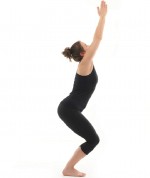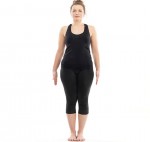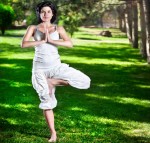There are postures that come to mind when you think about balance; there are postures that come to mind when you think about stretching; and there are postures that come to mind when you think about strength. And then there is Parsvottanasana.
Translated in English, Parsvottanasana (PARSH-voh-tahn-asana) means Intense Side Stretch Pose and the name couldnt be more accurate. Its also often referred to as Pyramid Pose. This pose is intense, but it also stretches much more than just the sides.
Parsvottanasana is good for the abdomen, the arms, legs, shoulders, hips and balance.
How to do Parsvottanasana
Starting in Tadasana or Mountain Pose, inhale, pivot your hips toward the back of your mat, take a wide step with your right foot and turn your left foot at a 45 degree angle. At the same time, bring your arms behind your back in reverse prayer. Exhale to align your heels, square your hips and firm your legs to create a steady base. Your feet should be firmly grounded before you initiate the fold.
As you inhale, expand your ribcage, and on the exhale, fold forward over your right leg, bringing your forehead to your shin.
Precautions and Modifications in Parsvottanasana
If you have knee or shoulder problems, youll want to take advantage of some modifications in Intense Side Angle Pose.
1. If you feel pressure on your shoulders, grab for the opposite elbow or reach your hands toward the ground or blocks.
2. If you feel pressure in your knees, place a slight bend in your knees.
3. If you have high blood pressure, avoid folding all the way forward. Instead, use a chair or the wall to support you with a flat back.
Tips for Beginners
In addition to the above modifications, yogis new to this posture should focus on the position of the feet. The shorter the stance, the steadier you will likely feel. Placing your hands on blocks will go a long way in improving your balance and allowing you to get the benefits of the posture.
While in the pose, focus on planting your feet, engaging your legs, and squaring the hips.
Theres a tendency for the torso to open. To fight this, bring your left shoulder towards the right knee and draw your right hip back. Bringing your right leg to the center line of the body while internally rotating the back leg will help too with your balance too.
On each inhale, expand your ribcage, and on each exhale fold further forward. Hold this pose for five breaths or as long as is comfortable before rising up on an inhale, then pivoting to the other side and folding as you exhale.
Benefits of Parsvottanasana
As mentioned above, Intense Side Angle Pose benefits nearly the whole body, the internal organs and the mind.
The posture stretches and opens the hamstrings, hips, spine, shoulders and wrists. It strengthens the legs, ankles and feet. Being a folding posture, Intense Side Angle massages the internal organs to improve digestion and calms the mind. Poses such as this which require such extreme concentration also go a long way in helping to cope with outside stressors. Like other balance poses, Parsvottanasana improves posture too.
This is a challenging posture. Take it slowly and make modifications as needed. With practice and by listening to your body, in time you will find yourself able to go deeper and achieve the full posture and its benefits.














